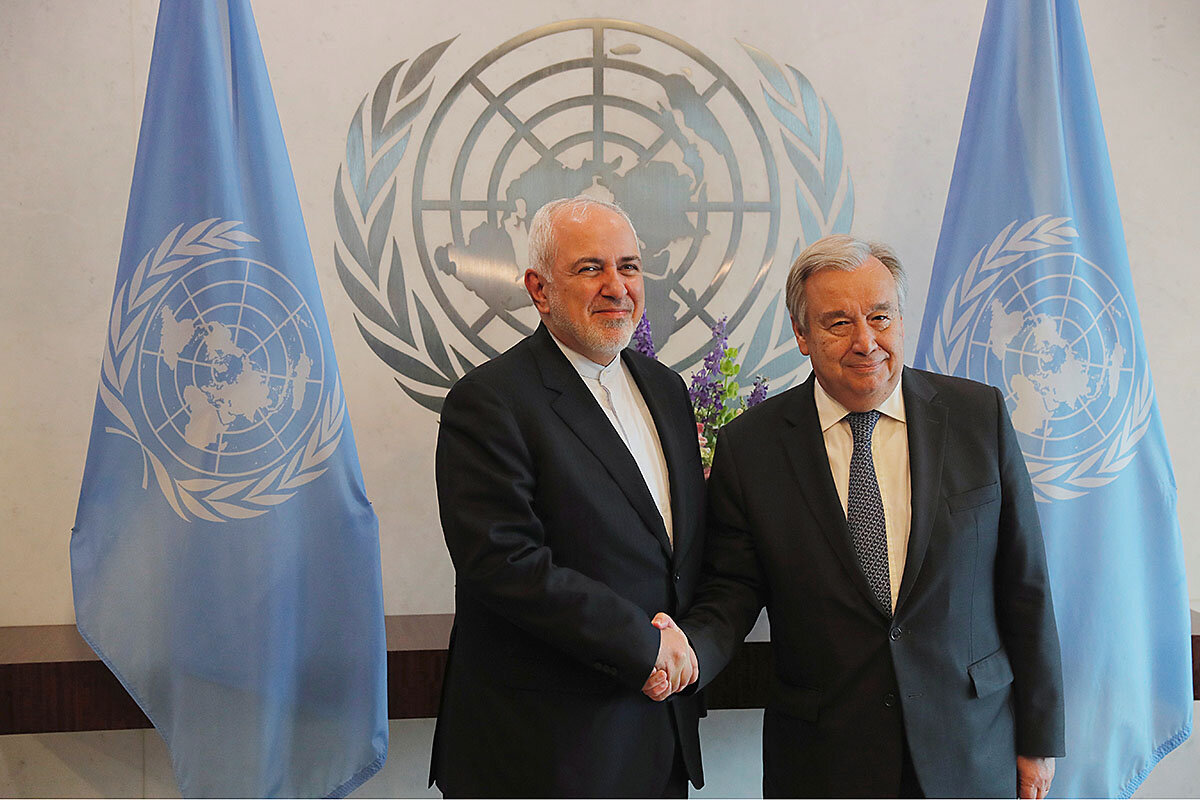Missing from US-Iran clash, a back-channel safety valve
Loading...
As tensions have risen between the United States and Iran over recent months, communications between the two longtime adversaries have been carried out over Twitter, through press interviews, and in speeches by leaders on the two sides – the latter more often than not aimed at domestic audiences.
When the U.S. Navy shot down an Iranian drone over the increasingly conflicted Strait of Hormuz Thursday, President Donald Trump announced the most recent incident in a statement from the White House. “This is the latest of many provocative and hostile actions by Iran against vessels operating in international waters,” he said. Iran on Friday denied it had lost any of its drones.
Missing from the mix of communications between the two foes, or so it seems, is the kind of back-channel diplomacy that U.S. administrations have often deployed in the past to cool tensions and avoid potentially catastrophic misunderstandings – or to pave the way to direct high-level talks.
Why We Wrote This
Back channels between adversaries always seem to be useful. They help limit tensions, and can pave the way toward peace. Yet as this round of U.S.-Iran tensions escalates, that outlet appears absent.
Indeed, the Obama administration used back-channel diplomacy with Iran to get to the long and intense negotiations – largely carried out by then-Secretary of State John Kerry and Iranian Foreign Minister Mohammad Javad Zarif – that resulted in the 2015 Iran nuclear deal.
Fast forward to mid-2019, and a very different U.S. president is employing roughly the same playbook with Iran that he did with North Korea before meeting with Kim Jong Un for the two leaders’ groundbreaking Singapore summit in 2018.
Tweets about Iran and pronouncements to the press in cabinet meetings or on the White House driveway are accompanied by a “maximum pressure” campaign of crippling sanctions designed, at least in part, to get the U.S. and Iran to the direct leader-to-leader talks Mr. Trump says he wants.
On the other side, Mr. Zarif sits down for interviews with the American press, while back in Tehran, the supreme leader, Ayatollah Ali Khamenei, gives fiery speeches in which he fulminates about an untrustworthy America.
A missing buffer
What is not part of the equation are under-the-radar contacts between governments that diplomats and regional experts say are a key part of keeping tense relations from spilling over into a hot conflict that neither side appears to want.
“The lack of open lines of communication between the Trump administration and the Iranian regime has led to a vacuum that makes it incredibly difficult to judge the messages the other side is sending and to understand the adversary’s motivations,” says Ned Price, a former CIA intelligence officer who served in the Obama White House National Security Council and is now director of policy at National Security Action, a Washington advocacy group.
What that means, experts say, is that when incidents occur – like Thursday’s drone shoot-down by the U.S.; or Iran’s confirmation earlier Thursday of its seizure of a foreign-flagged oil tanker in the Strait of Hormuz (through which passes more than a fifth of the world’s oil and petroleum products); or when Iran shoots down a U.S. military drone it says was over national air space, as it did in May; or the U.S. imposes a new round of sanctions on Iranian leaders and businesses – the diplomatic channels aren’t there for the behind-the-scenes contacts that could nip tensions in the bud.
Those tensions appeared to ratchet up further Friday when Iran said that it had seized a British-flagged oil tanker in the Persian Gulf.
“This vacuum we have now contributes to a situation where heightened conflict could much more easily spiral out of control,” Mr. Price says.
He cites the example of Iran’s seizure in early 2016 of two U.S. Navy patrol boats with 10 crew members in Iranian coastal waters – a situation that under other circumstances could have easily led to a dangerous standoff or worse.
“But those sailors were sent on their way less than 24 hours after they were detained by Iranian forces,” he says. “That outcome didn’t happen by accident, it happened because the open channels of communication at various levels made it possible for Kerry to pick up the phone and work this out with Zarif.”
Path to nuclear deal
Moreover, Mr. Price points to the contacts the Obama administration had established with Iran under the auspices of the Omani government – talks carried out over several years by a number of administration officials, including then-Deputy Secretary of State William Burns – and says it was those secret talks that paved the way to the nuclear deal between Iran and six international powers, also known at the Joint Comprehensive Plan of Action, or JCPOA.
“I’m not sure that if the Oman talks had leaked before the JCPOA was finalized, that we could have got to the finish line, that’s how critical those talks were,” he says.
Mr. Trump’s personal diplomacy with North Korea’s Mr. Kim offers proof, of course, that back-channel diplomacy is not a prerequisite for launching direct, high-level talks with longtime adversaries. What worries some experts, though, is that showy summitry without the painstaking behind-the-scenes diplomacy that sets terms and defines expectations first can perpetuate misunderstandings and lead to bad deals for the U.S.
“What the North Koreans have learned from the two summits with Trump is that he is much more impetuous, much more willing to agree to things without prior negotiations or understandings of them than either [national security adviser John] Bolton or [Secretary of State Mike] Pompeo would be,” says Bruce Klingner, senior research fellow for northeast Asia at the Heritage Foundation in Washington. “That leaves us where we are today, with the North Koreans refusing to meet with anyone other than Trump … and the growing realization that the North Koreans don’t really want to denuclearize.”
Indeed, some supporters of Mr. Trump’s foreign policy approach – and perhaps even the president himself – appear to be convinced that the administration needs some kind of ice breaker with Iran if direct talks are ever to come to fruition.
Channel blocker?
According to recent press reports, Kentucky Republican Sen. Rand Paul used a golf outing with the president last weekend to propose he act as the administration’s bridge to the Iranian regime. His plan was to meet soon with Mr. Zarif, according to an account first reported in Politico. Mr. Zarif has been in New York this week for meetings at the United Nations.
And according to some White House officials, Mr. Trump gave the initiative his OK on the spot.
By Thursday Mr. Trump was denying he had appointed Mr. Paul as any kind of emissary, saying only that he had spoken with the senator and “he’s somebody I listen to.”
Still, some analysts saw in the episode at least tacit acceptance of the merits of a diplomatic back channel. Beyond that, the fact that a plan that presumably would have been carried out under wraps was so quickly outed in the press tells some with White House experience that some powerful people didn’t want the idea to go forward.
“My suspicion is that somebody put it out there with the intention to scuttle it,” says Mr. Price, who served as senior director for strategic communications on the National Security Council in the Obama White House. “Obviously Rand Paul’s views on Iran policy are very different from those of the Boltons and Pompeos of the administration,” he adds. Mr. Paul is a non-interventionist who had praised the president’s decision to call off retaliatory air strikes over Iran’s downing of a U.S. surveillance drone last month.
Yet as important as a diplomatic back channel might be to defusing incidents and potential blow-ups, some analysts say established lines of communication and quiet conversations are even more critical to substantive and successful diplomacy on a complex issue like Iran’s nuclear program.
“If you want to defuse the potential for missteps, you need to be able to communicate,” says Mr. Klingner of Heritage. “But even more, if you want something better than the JCPOA, at some point you have to sit down and negotiate.”







